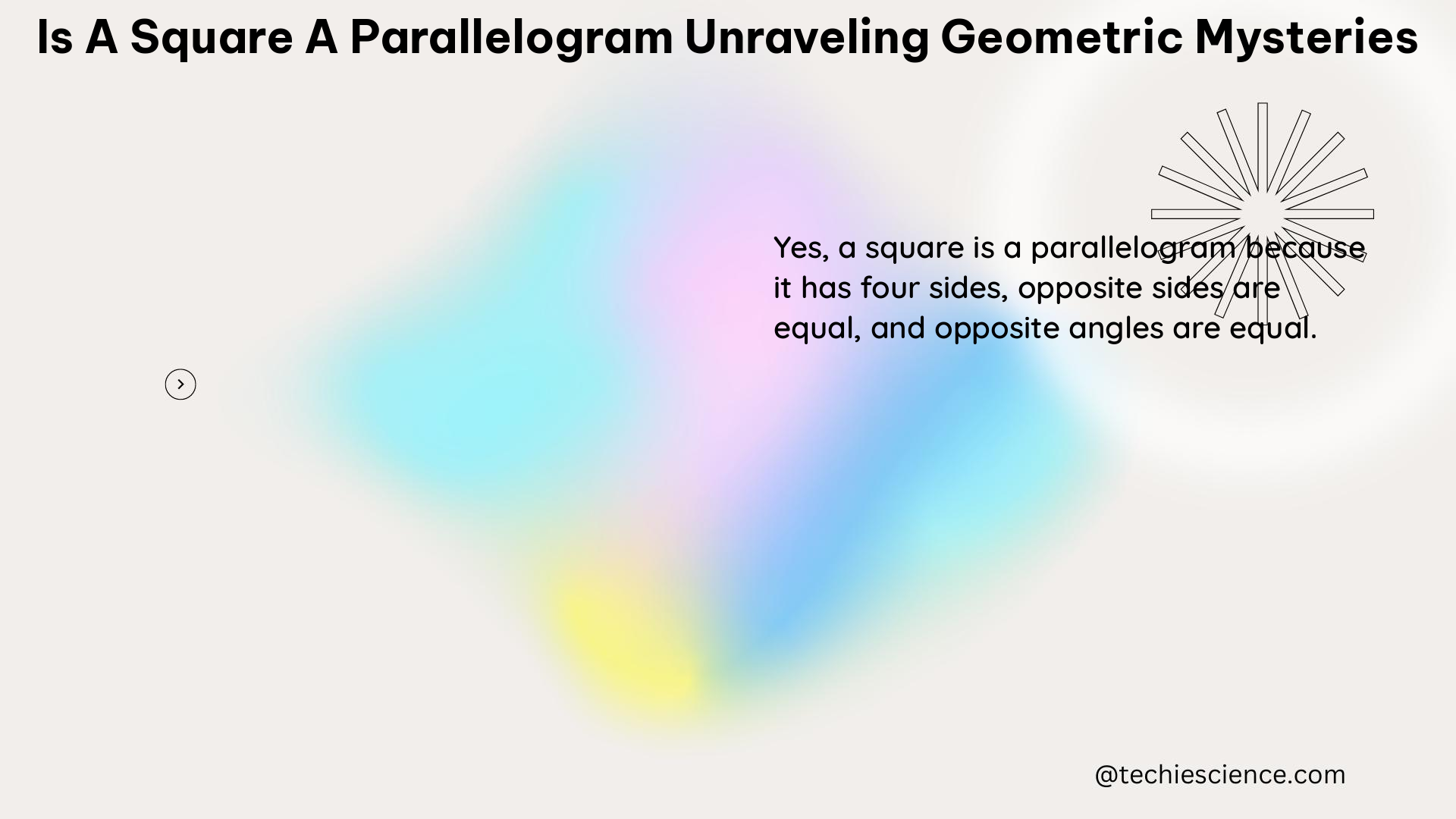A square is indeed a special type of parallelogram, with unique properties that make it a fascinating subject of study in the realm of geometry. In this comprehensive guide, we will delve into the intricate details that define a square as a parallelogram, exploring its measurable characteristics and the underlying mathematical principles that govern its behavior.
Understanding the Parallelogram Properties of a Square
A parallelogram is a quadrilateral with the following defining properties:
- Opposite Sides are Parallel and Equal in Length: In a parallelogram, the opposite sides are parallel and equal in length.
- Opposite Angles are Equal: The opposite angles in a parallelogram are equal in measure.
Now, let’s examine how a square, as a specific type of parallelogram, satisfies these criteria:
- Opposite Sides are Parallel and Equal in Length: In a square, all four sides are equal in length, and the opposite sides are parallel. This means that a square meets the first requirement of a parallelogram.
- Opposite Angles are Equal: In a square, all four angles are right angles, measuring 90 degrees each. Since the opposite angles are equal, a square also satisfies the second requirement of a parallelogram.
Therefore, a square can be classified as a parallelogram, as it possesses all the necessary properties that define a parallelogram.
Measurable Properties of a Square as a Parallelogram

To further understand the relationship between a square and a parallelogram, let’s explore the measurable properties of a square:
Perimeter of a Square
The perimeter of a square is the sum of the lengths of all its sides. Since all four sides of a square are equal, the perimeter can be calculated using the formula:
Perimeter = 4 × side length
For example, if a square has a side length of 5 units, its perimeter would be 20 units (4 × 5 = 20).
Angle Sum of a Square
The sum of the interior angles of a square is 360 degrees. This is because a square has four right angles, each measuring 90 degrees, and the sum of the angles in any quadrilateral is 360 degrees.
Area of a Square
The area of a square can be calculated using the formula:
Area = side length × side length
For instance, if a square has a side length of 7 units, its area would be 49 square units (7 × 7 = 49).
Diagonals of a Square
The diagonals of a square are equal in length and bisect each other at right angles. This means that the diagonals of a square are perpendicular to each other and divide the square into four congruent right triangles.
Inscribed Circle of a Square
A square can be inscribed in a circle, with all four vertices touching the circle. The radius of the inscribed circle is equal to the side length of the square.
Transforming a Square into a Rectangle
One interesting property of a square is that it can be transformed into a rectangle by cutting it along one of its diagonals. This transformation highlights the relationship between a square and a rectangle, as both are types of parallelograms.
Conclusion
In conclusion, a square is a special type of parallelogram that possesses unique measurable properties, such as equal sides, right angles, and equal diagonals. By understanding the underlying principles that define a parallelogram and how a square satisfies these criteria, we can unravel the geometric mysteries that make this shape a fascinating subject of study.
References:
- Joshua A. Taton in Education Presented to the Faculties of the University of Pennsylvania. (2013). A Mathematician and Architect of the CCSS-M Dramatically Illustrates the Complexity of Coherence and the Notion of Connecting Ideas in Mathematics. Retrieved from https://repository.upenn.edu/server/api/core/bitstreams/a9876420-7b78-4391-ba8d-8bd53f33ceba/content
- How to Find the Area of a Parallelogram – YouTube. (2020, March 22). Retrieved from https://www.youtube.com/watch?v=uj6k22WubCk
- Abstracts of Papers Presented at MathFest 2023. (2023). Retrieved from https://maa.org/sites/default/files/pdf/mathfest/2023/AbstractBook2023FINAL.pdf
- HIDDEN MATHEMATICS – Randall Carlson – Ancient Knowledge of Geometry Classes. (2020, December 08). Retrieved from https://www.youtube.com/watch?v=R7oyZGW99os
- Psychological Research on Insight Problem Solving. (2013). Retrieved from https://www.researchgate.net/profile/Michael-Oellinger/publication/238605884_Psychological_Research_on_Insight_Problem_Solving/links/55926f8108ae15962d8e6af2/Psychological-Research-on-Insight-Problem-Solving.pdf

The lambdageeks.com Core SME Team is a group of experienced subject matter experts from diverse scientific and technical fields including Physics, Chemistry, Technology,Electronics & Electrical Engineering, Automotive, Mechanical Engineering. Our team collaborates to create high-quality, well-researched articles on a wide range of science and technology topics for the lambdageeks.com website.
All Our Senior SME are having more than 7 Years of experience in the respective fields . They are either Working Industry Professionals or assocaited With different Universities. Refer Our Authors Page to get to know About our Core SMEs.